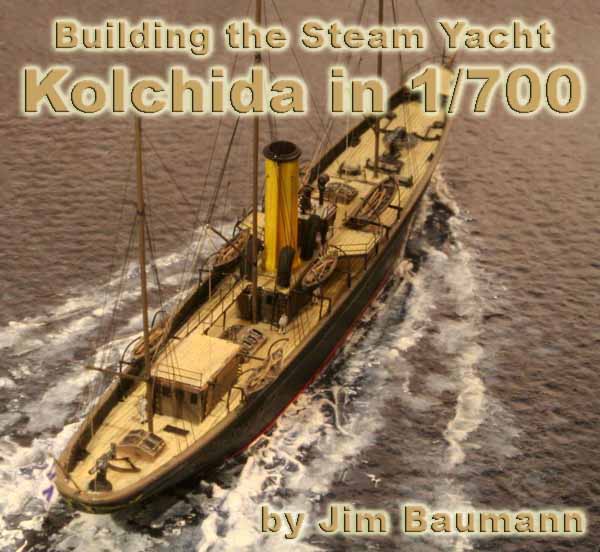

|
Kolchida was the former yacht Tamara built in 1898. Purchased by the Russian Naval Ministry in June 1913 and converted into communications vessel attached to the Black Sea Fleet HQ. During conversion she was fitted with an extremely powerful radio set that was able to communicate directly with St. Petersburg, which gave her a small but significant place in her Nations history. October 25 …When the cruiser Aurora fired (blank) shots at the Winter Palace in St. Petersburg, It was to be the day of the victory of the October Revolution. At 10 a.m. the Military Revolutionary Committee accepted the appeal ‘To the Russian People’, signed by Lenin, in which the overthrow of the Provisional Government and the handing over of all powers to the workers and peasants was proclaimed. This appeal was broadcast by the radio station of the cruiser Aurora and the port radio station New Holland, and reached southern Russia within that same hour. This momentous news broadcast was received by the yacht Kolchida, a humble dispatch vessel of the Black Sea Fleet. On that day the vessel was situated in Rostov-on-Don. During the historic meetings of the II Soviet (council) Congress on 25 and 26 October, and following reports by Lenin, the first very important decrees of the Soviet authority/ regime were accepted. Through these decrees, the main demands of millions of workers were being recognized. The decisions of the II Pan Russian Soviet Congress that legislatively confirmed the victory of the armed October uprising in Petrograd, and the victory of the Great Socialist October revolution, were also received from Kolchida’s radio station, coming from the far shores of the river Neva. This hitherto insignificant messenger ship which was converted in 1913 from a former Tsarist yacht unwittingly found itself in the center of the revolutionary activities on the River Don as people in southern Russia learned about the first decrees of the Soviet regime almost immediately from that mobile floating radio station. In those fast moving historic days, people began calling Kolchida the ‘Aurora of the Don river’. The vessel was converted in 1919 to a Minelayer and re-named Pernac. In February 1920 this historic vessel was wrecked off the Bulgarian Coast at Cape Kara-Burun. Pernac was carrying Refugee Russian Officers and their families who wished to emigrated to Varna in Bulgaria. The Bulgarian authorities had denied entry, so in a storm the vessel was run onto a marked reef –All crew and passengers were rescued and subsequently accepted into Bulgaria as shipwrecked cast-aways…. Three years later attempts were made to raise the vessel from the bottom of the sea, but these were unsuccessful. Divers however managed to bring several objects from the ship to the surface. Today, these artifacts from the Kolchida are kept in the military naval museum in Varna/ Bulgaria;: a binnacle with a magnetic compass, and the Figurehead of the yacht-, the head of a Golden Eagle carved out of wood. A model of the vessel Kolchida can be found in the local district museum of Rostov-on-Don.
|
|||||||||||||||||||||||||||||||
| Building the model | |||||||||||||||||||||||||||||||
| I retrieved this simple little kit from the bottom of my
stash cupboard having purchased it many years previously. Upon opening
the box I was struck again immediately by her elegant lines, delving into
the internet produced virtually no usable information gradually however
a number of Russian, Finnish and German maritime (web) researchers offered
snippets of information on the history of this intriguing ship.
Eventually George A. Shishoff (webmaster of the Tsushima photo web-site) sent me the link to a usable and verified drawing of the ship here. Armed with historical background and a drawing it became evident that the kit was based on that drawing. The kit out of the box comprised a very pretty hull casting and a mixed bunch of parts with a considerable quantity of ships boats with some very finely rendered deck details |
click images
to enlarge |
||||||||||||||||||||||||||||||
 |
|||||||||||||||||||||||||||||||
 |
|||||||||||||||||||||||||||||||
 |
|||||||||||||||||||||||||||||||
| I removed all cast on raised windows using Micro Chisel, cut away all the cast stairways all around and removed the large casting base. Due to its diminutive size the painting of all the fine details was challenging. The removed windows were replaced with small strips of Matt vinyl tape, sealed with CA and Matt varnish. Once the cabin sides had been painted using a fine brush and a magnifier I indicated the window divisions according to the plan in brown paint. The boat stowage racks were made of cut down 1/350 handrail PE, | |||||||||||||||||||||||||||||||
| The catwalk between the deckhouses was a strip of brass furnished with handrails. All stairs were replaced with WEM items, however because these were significantly steeper, so I elongated the side rails of the PE to conform to the desired angle. |  |
||||||||||||||||||||||||||||||
| The remainder of the construction was very straightforward.
I made a binnacle and wheel from brass rod and PE, a searchlight was scratchbuilt
so as to have a see thru bracket, doors were added along with some fine
davits for the boats made of copper wire. Unfortunately all the boats in
the kite were according to my 1/700 scaled down plan far too large and
were substituted with nearer equivalents from the scrap box. Oars were
made of brown stretched sprue installed with liquid cement so that they
all bedded down. The masts were made of steel rod with brass spars rigged
as usual with stretched sprue.
The ensign was made of paper with a blue ball-point cross and the ship was mounted on a base of textured artists watercolor paper, painted and sealed with Gloss coat varnish. A most endearing subject, enjoyable to build and most unusual. I feel proud to have honored this plucky little ship, virtually unheard of outside of Russia, in model form 87 years after her loss. |
|||||||||||||||||||||||||||||||
|
|||||||||||||||||||||||||||||||
| More of Jim Baumann's work. | |||||||||||||||||||||||||||||||